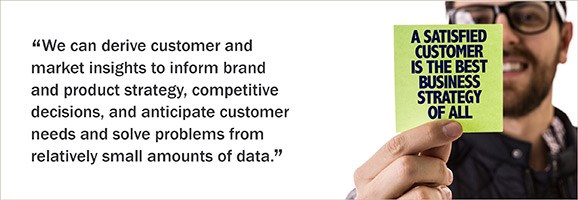Why Even a Little Data Matters (And What to Do About It)
We live in a data rich environment. Even so, many companies still struggle to transform their data into meaningful and actionable insights. Driving outcomes from your data takes turning knowledge into action. Yielding insights doesn’t take as much data as you think. Here’s a personal example of how a company could use a little data to provide a better customer experience.

By Laura Patterson, President
VisionEdge Marketing, Inc.
We live in a data rich environment. Even so, many companies still struggle to transform their data into meaningful and actionable insights. In fact according to a Forrester study, only about 29% of companies are actually successful at connecting analytics to action. Driving outcomes from your data takes turning knowledge into action. In reality, yielding big insights doesn’t take as much data as you think. Here’s a personal example of how a company could use a little data to provide a better customer experience.
My sister recently lost her beloved cat, Blue. He had been failing in health for awhile and was on a variety of medications. She purchased the medications from an online pet pharmacy. She had placed an order for a particular medication a week before Blue died. Blue passed away over the weekend and first thing Monday morning she called the pharmacy to cancel the order. The pharmacy confirmed that the order had not yet shipped and also informed her that there would be a $25 restocking fee. She said in between tears, “but he’s died and I’m calling you as soon as possible.” The customer service person said, “that’s our policy.” Let’s put personal interaction aside and look at how this company could use a little data to create a different customer experience that would benefit both the company and the customer.
When my sister first began using this pharmacy she completed a registration that provided information about her and her pets, the type of pets, their ages, whether she has pet insurance, and so on. In this case, two pets, because she has two cats. When she submitted the prescription for the medication in question it included a diagnosis. With very little data this company now has information about my sister, her pets, and their condition. They know she is a caring pet owner because she is going through the effort of securing medication that is expensive and she doesn’t carry pet insurance, so she is willing to spend money to help extend her animal’s life. A big insight from a few fields of data. With this information, the company can begin cross-selling products they carry that don’t require a prescription, such as vitamins that might help improve Blue’s condition.
Fast forward to the recent incident. There is a field “reason for cancelling or returning” on the order cancellation form. One of the options in the menu is “pet died.” With a little data review, the company could learn how many orders are cancelled due to the loss of a pet. Many pet owners think of themselves as pet parents (personas in the making here – pet owners, pet parents/grandparents, pet advocates/fosters – I can see the field in my mind on the registration form). Pet parents are extremely affected by the loss of their pet family member. For the sake of conversation, let’s imagine that cancelling medications for pets who have passed happens frequently. This little piece of data could have big implications to policies, such as restocking and customer service. A big insight from a little data that doesn’t take myriads of systems and heavy lifting analytics.
How Can Your Company Best Use This Information?
Here’s how a company might use this insight. Perhaps the restocking fee would be less or even mitigated in the loss of a pet (yes, I suspect you are thinking we might need some verification from the vet). Then imagine that a final part of the process would be to send the pet parent/owner a “sympathy card/email” that also thanks them for their business. Now we have created a different experience.
Since my sister has another cat she will likely continue to use this pharmacy, although she might be tempted to do a bit shopping around. But if the company had employed a different process, this experience might have made her an advocate for the company. One fact about pet owners, they tend to adopt more pets. My husband and I have now been parents to six dogs. I can’t imagine we won’t have another when our current two pups are gone. My pups are both seniors, so medication is in their future. My sister would have been a good resource for where to buy medications. Imagine how much stronger her recommendation would have been had she not been talking through tears on that Monday about Blue’s passing and her situation with the online pharmacy restocking fee.
How to Pivot from Insight to Action
Marketing is more than program development and implementation. Customers are our focus. Marketing with a capital “M” includes creating and improving the customer experience. Avoid getting swept up in the complexity of data, analytics, and technology. The data in our arsenal doesn’t have to be extensive to be actionable. We can derive customer and market insights to inform brand and product strategy, competitive decisions, and anticipate customer needs and solve problems from relatively small amounts of data. We know from Tom Davenport’s work that companies with analytical muscle are stronger competitors.

Decide what your team needs to do to function as an insights-driven organization and craft your action plan. Identify opportunities where you can bring big insights to the conversation and gather the necessary data. Be clear about the vision and outcome. For example, I recall back in the 1990s (yes, a lifetime ago) the organization I was with had an initiative to reduce the time from product order to delivery from 26 weeks to 7 days. To do this we needed to understand the journey of the product. Turns out there were lots of trucks, planes, ships, and holding areas along the course of the product’s journey. We were able to ascertain how long the product was in each stage of its journey. This was the 1990s and yet we were able to obtain this data with a relatively minimal effort.
With a little analysis we could see where the product spent its time and decide how to chip away at reducing the cycle time. We didn’t get to 7 days, but we did get to under 2 weeks! The point is we had clarity around the customer needs and the data necessary to address the need. Once we had the data we optimized for identifying big insights that we could act upon to produce better results. Reducing the cycle time became a competitive advantage directly improving the customer experience and the likelihood for repeat purchase.
In their Insights-Driven Business report, Forrester claims that by 2020, the combined annual revenue of insights-driven businesses will be $1.2 trillion and that insight-driven businesses will grow faster, at 27 percent for public companies and 40 percent for startups, than the projected global GDP growth of 3.5 percent. No business today can afford to not be insights-driven. Learn more about how to transform your data into actionable insights with the complimentary white paper Intuition to Wisdom: Transforming Data Into Models and Actionable Insights https://visionedgemarketing.com/enhance-your-know-how-with-white-papers/.
Need more information?
Laura Patterson, President
VisionEdge Marketing, Inc.
P.O. Box 342546
Austin, TX 78734
512-681-8800 Ext. 12
About the Author
Laura Patterson
Laura is president and co-founder of VisionEdge Marketing, Inc., a recognized leader in enabling organizations to leverage data and analytics to facilitate marketing accountability and operations, measure and improve marketing performance, develop dashboards, and enhance marketing and sales alignment in order to accelerate revenue and create a competitive advantage. During her career of 30-plus years she has owned and led various marketing, sales, and management initiatives. Laura’s areas of expertise include the science side of marketing – analytics, processes, systems, metrics, and research – as well as branding, customer loyalty and product rollouts. She has authored Metrics in Action: Creating a Performance Driven Marketing Organization, Measure What Matters: Reconnecting Marketing to Business Goals, and Gone Fishin': A Guide to Finding, Hooking, Keeping and Growing Profitable Customers.
RELATED CONTENT
-
Drive More Web Traffic from Social Media
These helpful social media tactics can drive more traffic to your site. If you’re consistent in your efforts, you eventually will start noticing results. How can you reap the web traffic benefit and more? Here are nine ways to help.
-
Marketing Messages That Cut Through The Noise
We’ve talked about customer journeys, emotional intelligence, and finding and retaining customers. You’ve tuned up your marketing messages. Now it’s time to decide where to place them, so customers tune in. In a world with endless channels of information, how do you become a source of knowledge — not noise? One step at a time.
-
5 Tips for Making Print Advertising More Measurable
Print advertising can still be extremely valuable, especially in the manufacturing sector. Learn how to integrate your print advertising in trade publications with your digital campaigns to make them more measurable and improve your ROI.


